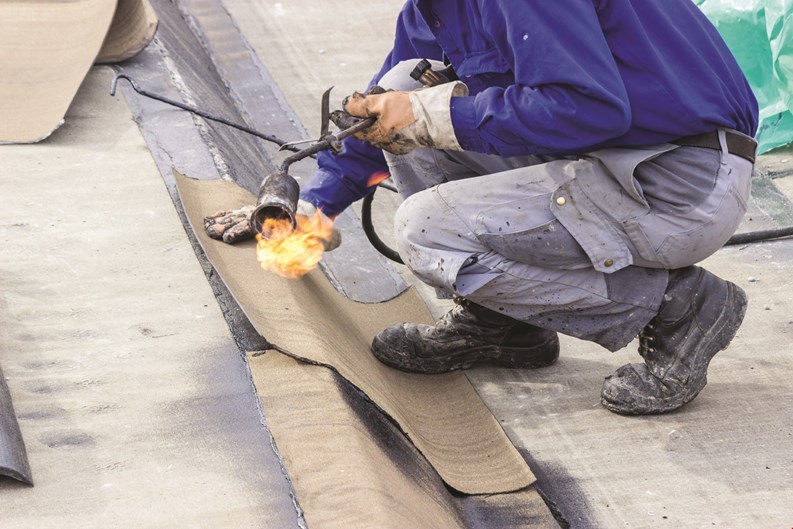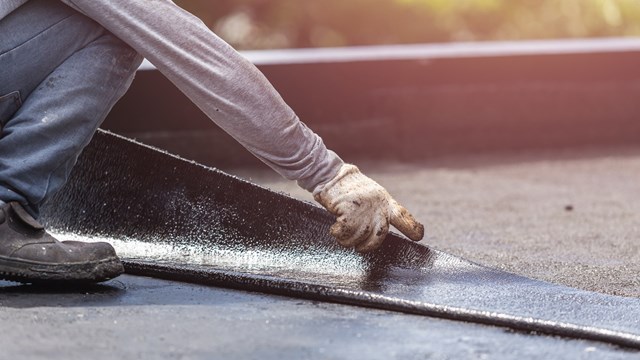A building’s roof serves as the first line of defense against whatever the skies throw at its inhabitants—wind, rain and blazing sun, even snow and ice in some climates—so it’s crucial for that roof to be sound and well maintained. All it takes is one small crack or hole for the rainwater to get in and, poof! There go thousands of dollars in repair and potential insurance claims (not to mention the damage it can cause to residents' possessions and property). Knowing how to maintain and repair what's on top of your buildings can ultimately protect your bottom line.
What's Up There?
According to James R. Kirby, AIA, the director of technical services for the national Asphalt Roofing Manufacturers Association (ARMA), the most common types of roofs in dense urban areas are 'low-slope' or flat roofs. “The roof types include asphalt-based roof systems, called built-up and modified bitumen, and single-ply roof systems,” he says.
“The building designer most commonly determines if a rooftop is steep-slope (pitched) or low-slope (flat),” says Kirby. “Most tall buildings have low-slope roofs because the roof is not a visible architectural element. Low-slope roof systems include a roof deck (which in this context is the base layer upon which the other roofing materials sit—not a recreational common area), a vapor barrier if needed, at least two layers of insulation, a cover board, a membrane, and some type of surfacing.”
Along with urban high-rises, New England also has many suburban condominium communities featuring townhouses or garden-style buildings that are topped with sloped, shingle roofs. Shingles are most often asphalt, slate, wood, tile or metal and most common is probably asphalt shingles.
How long a roof lasts will depend on what it’s made of and how it’s maintained. “It used to be that shingles were good for 25 or 30 years. Now, they have ‘lifetime’ shingles,” says Mike McDuffee, project manager at Corolla Roofing in Winthrop, Massachusetts. That, he says, translates to about a 40-year lifespan for the currently-popular architectural style shingles.
On flat roofs, tar-and-gravel roofs were once common, but PVC and rubber roofs are seen more often today. “In my opinion, the best buy for the buck is a rubber roof … because it’s very serviceable, very repairable. And the life span is probably 40 to 50 years, with today’s seaming technology,” McDuffee says. “The key is to have a properly-installed roof system.”
“If a shingle roof is done right, it’s not going to have problems,” McDuffee says. “If it doesn’t leak in the first couple of years, it’s probably good for many years.”
No matter how durable the materials or how well they were installed, at some point a roof will begin to deteriorate under stress from the elements. Sections can begin to break down, allowing moisture to seep in and cause damage. The most vulnerable parts of a roof are at the perimeters and at penetration points, such as vents, skylights, and water tank footings. “Seams and flashing are the weak spots,” McDuffee says.
Damage Control
“The two worst things for roofs are sun and people,” he says. “If you can keep people off your roof, you’ve added a lot of life to your roof; if you can keep the sun off your roof, you’ve added a lot of life to your roof.”
Buildings that have usable rooftops, such as sun decks or other recreational common spaces, have their own set of problems. “Typical maintenance concerns include penetrations in the roof membrane when the deck is installed, as well as furniture, BBQ equipment, plants, and so forth that may have sharp edges that can puncture the roof membrane,” says Chuck Goss, president and founder of Cooper Roofing, based in Trenton, New Jersey.
“When you have a (recreational) deck, if a leak occurs, it can be difficult to find the problem,” McDuffee says. “If it’s under the deck, you have to start removing the deck boards to see what’s going on.” Problems can occur, he notes, when decks or other recreational amenities are installed on the roof; a buffer is needed between the deck and the roof membrane itself.
Buildings with recreational spaces on their roofs should have those elements checked more often. Despite their longevity and seeming durability, roofs can be delicate. Workers repairing rooftop equipment may drop tools, inadvertently cut the roofing material or damage the flashing. “People drop things on the roof, between the deck boards. Someone even started a fire on a deck in the Back Bay,” McDuffee says. “A roof is not a play yard; that’s not what it was intended to be.”
And even though this past winter was pretty mild for most of the country (as of this writing, anyway), climate plays a huge role in a roof's life span—but it’s not just about how many inches of rainfall, or how hot the summer is.
“Climate is a huge impact, so roofers in different regions adjust their materials to weather the climate of the area,” says Goss. “Sun dries out the oils in the material, and ice will cause the material to crack. Even an abrupt temperature change can create what's called ‘thermo-shock.’ That typically happens when temps change 30 to 35 degrees in a 24-hour period.”
And efforts to care for the roof can sometimes backfire. The snow and ice dumped on New England in early 2015 led to major snow-removal projects, often conducted by untrained workers— and in the spring, the Corolla team was called out to rescue buildings from water leaks. “We found lots of damage caused by snow removal. It was clear to us that’s what the problem was,” McDuffee says. “If you’re going to remove snow, leave an inch of snow on the roof, and use a plastic shovel only.” PVC roofing is especially brittle in cold weather, and some workers smashed frozen puddles on flat roofs with their shovel handle—often smashing the roof itself, he notes.
And there seems to be an increase in snow-removal, even though it’s not needed most winters. “Last year was a rare exception,” he says. “Usually, when you have a roof cave in, it’s on a metal-roof warehouse or abandoned building. But for average buildings, 98 percent of them are made to take the weight” of a normal winter snow load.
Roof Inspections
After a certain number of miles driven, you change the oil in your car and rotate your tires. The same concept should be applied to the maintenance of the roof. “The National Roofing Contractors Association (NRCA) guidelines traditionally suggest inspecting your roof in the spring and in the fall,” says Matthew Baker of Illinois-based Raincoat Roofing Systems, Inc. “Most warranties say at least once a year, and that inspection would happen in the fall.”
And it’s not really enough just to have your superintendent or building maintenance person go up and give the roof a quick once-over. These inspections should be conducted by a professional roofing contractor who is able to see small problems before they become dangerous or expensive. “I strongly encourage building owners to have the roof inspected every fall,” McDuffee says.
Last year, Corolla was called on to solve “torrential” water leaks throughout a building. It turns out that the drains on the flat roof were clogged— “and we discovered 50 to 70 cuts that had been caused by snow removal.” When the roof filled with rain, the pressure pushed the water through the roof and into the building. “If we had done an inspection that fall, we would have found those cuts.”
The key points of an annual inspection follow the most common causes of roof failure. “We start by making sure the drains are clear, then inspect the base flashing of the roof penetrations, inspect the roof edge metal, then on flat roofs, inspect the membrane seams. On the shingle roofs we look for any missing or damaged shingles,” says Goss. “Also, the pipe collar flashing should be checked in detail to see if it is starting to crack or wear.”
Inspections often reveal tipped-over antennas, broken skylights, crumbling chimneys—even raccoon damage, he says. As part of an inspection, McDuffee says, Corolla workers will also do small repairs on the spot: “If it’s an easy fix, we just do it at no extra charge.”
Baker says that on his inspections, he looks up. “You need to look at the ceilings, where you can see where water infiltration issues are, or where there were problems in the past,” he says. “Also, look at how much debris is on the roof. Generally, if it’s a housekeeping mess, you know that the maintenance staff and property manager do not really take care of the roof. Our objective is to try and maximize the lifespan of the roof. There are times you can fix it, but there are times that you have to be upfront with the customer that it’s time for replacement. The rule is that if you are spending more than 5 to 7 percent of replacement cost on repairs in a given calendar year, you should be considering a replacement.”
The cost of an inspection depends on the size of the building and ease of access, as well as how detailed the report has to be. “The average cost, depending on the size of a building, is probably about $1,500. But you can be sure that if you don’t have an inspection—you just cross your fingers—and then you have a leak, it’s going to cost you more,” McDuffee says.
Building Staff
So, in-depth roof inspections should be done by a qualified specialist. But are there any roof problems that can be handled by a building staff member? That depends. “The maintenance is going to depend on the warranty, but the only one who should be working on the roof is someone who is certified to work on that system,” says Baker. “If you go up and are not a roofer, you can end up using tools or materials that aren’t compatible with the system you have. That can lead to additional costs, and even catastrophic failure.”
That said, your building’s maintenance staff can remove debris that can cause latent damage, like leaves, branches and bottles that can puncture the roof membrane or cause deterioration by allowing moisture to pool or seep into the surface.
“They should regularly examine masonry and metal work for signs of deterioration or water infiltration,” says Kirby. “Another way to maintain a roof is to make sure that rooftop equipment is in proper working condition and, where necessary, piped to drainage. Lastly, minimizing unnecessary foot traffic on the roof will help avoid potential damage. That means keeping access doors locked, and requiring any rooftop visitors and workers to sign in or be escorted.”
Depending on location, roofs and drains need to be cleaned between two and four times a year. “This can also be done by maintenance staff with OSHA fall protection knowledge,” says Goss.
“Roofs are not indestructible, and should be treated with respect,” says Kirby. “Appropriately constructed roof decks, and the use of walkway pads and protection layers are necessary if residents expect to use a roof and for that roof to last. The best advice is to stay off the roof; reduce foot traffic; don’t use a roof as a work or play platform.”
Lisa Iannucci is a freelance writer and a frequent contributor to New England Condominium. Associate Editor Pat Gale contributed to this article.







Leave a Comment